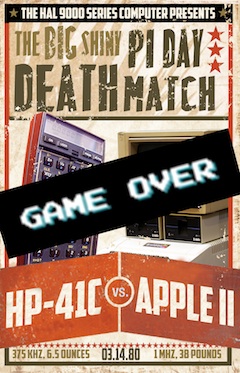 Well, Pi Day has come and gone, so what’s left for a Pi nerd to look forward to? Tau Day? Heresy! That other Pi Day, July 22nd (22/7)? Pa-lease. Accept the fact that it’s OK to talk about Pi when it’s not Pi Day? Sure, why not?
Well, Pi Day has come and gone, so what’s left for a Pi nerd to look forward to? Tau Day? Heresy! That other Pi Day, July 22nd (22/7)? Pa-lease. Accept the fact that it’s OK to talk about Pi when it’s not Pi Day? Sure, why not?
A random thought caught my attention after I posted my article Pi Day Rematch: Apple II vs. HP-41C that suggested that I could have been more fair to the HP-41C by highlighting some of it’s obvious strengths, e.g. portability and energy efficiency. And, I got a lot of personal emails expressing that thought as well. (In my defense, it wasn’t I that compared the two in the first place–some people are just too serious :-).
Lets be honest, was there any doubt in anybody’s mind that a late ’70s pocket calculator could best an Apple II in a 1000 digit drag race? Or ENIAC for that matter? However, what if, you had to compute Pi within a fixed energy budget of 1 Wh or on a flight to Paris? Which would you choose?
Energy Efficiency
I remember a time when the energy utilization of home computing equipment was never given a second thought other than, “turn it off before you go to bed.” Fast-forward to today: Our consumer electronics have a plethora of energy saving options, e.g. my computer suspends when not in use, my external drives spin down when unused, my fridge has a vacation mode, all my LCD TVs have a green mode (my Sharp rates your energy efficiency with green leaves (0-5)), my electric utility company wants to control my air conditioner, etc… Today, energy utilization matters. So, lets pretend it mattered in 1980. You’ve got a 1 Wh budget to compute Pi to 1000 digits. What do you use, the Apple II or the HP-41C?
The community members of comp.sys.apple2 and MoHPC were kind enough to measure the power consumption of the Apple II and HP-41C and reported 24 Watts and 72 mW respectively.
The best Apple II and HP-41C times reported by my tests were 194 seconds and 08:21:57 (30,117 seconds) respectively making the energy used 24W*(194/3600) = 1.29 Wh and 0.072W*(30117/3600) = 0.60 Wh.
It should be obvious why. The Apple II, as a general-purpose computer, has a lot of unused powered components where as the HP-41C, while still a computer, is a limited-purpose device for specific computational tasks. To further handicap the Apple II, the Apple II has to convert from AC to DC. The drop in efficiency for retro tech could be as high as 50%. However, none of that takes away from the fact that for computational intensive tasks, at least those involving Pi, the HP-41C is more efficient.
The table below contains all the benchmarks that I ran with their estimated energy usage. The original Apple Pi uses more than 1000 times the energy of the HP-41C; a whopping 1KWh!
|
Platform
|
Code
|
Base | Time(s) | Watts | Wh |
|
HP-41C
|
RPN
|
105 | 30117 | 0.072 | 0.60 |
|
Apple II
|
Assembly
|
10 | 194 | 24 | 1.29 |
|
Apple II
|
MAF
|
216 | 1496 | 24 | 9.97 |
|
Apple II
|
cc65 2.13
|
216 | 1514 | 24 | 10.09 |
|
Apple II
|
Aztec C
|
216 | 2180 | 24 | 14.53 |
|
Apple II
|
Integer BASIC
|
10 | 150410 | 24 | 1002.73 |
Portability
The HP-41C is a remarkable late-’70s gadget. It has a display, an alphanumeric keyboard, a file system, removable storage, expandable memory, and sports general purpose programmable I/O (via HP-IL); all the earmarks of a ’70s computer, and it fits in your pocket.
Lets say that you are traveling non-stop to Paris from my hometown, and in the 10-11 Hr journey you need to compute at least 704 digits of Pi so that you can personally confirm that the digits of Pi in the Palais de la Découverte “π Room”, that were originally incorrect until corrected in 1945, are actually correct[1, pp. 50].
No contest here. There isn’t a pocket-able Apple II product unless you count emulation on the iPhone/iPad. What you need is a very capable, energy efficient, pocket computer–the HP-41C. 704 digits in < 10-11 Hr? No problem, it'd take a little over 4 hours. You can use the rest of your time to compute e. Too bad there isn’t an “e room”, or is there?
The “π Room”
 No, I didn’t compute Pi on my way to Paris, but just knowing that I could have with my 41CX in my pocket reassured me. :-)
No, I didn’t compute Pi on my way to Paris, but just knowing that I could have with my 41CX in my pocket reassured me. :-)
All Pi nerds (make that all nerds) that find themselves in Paris should make the pilgrimage to Palais de la Découverte to visit the only “π Room” in existence (or so I have been able to find). This science museum is a short walk from the Eiffel Tower, so if you are willing to spend the time to see a marvel of French engineering, then you might as well go see the most fabulous piece of calculation ever performed[2, pp.406] by an Englishman.
William Shanks of England
 William Shanks (1812 – 1882) was an amateur mathematician and IMHO is still the king of all Pi nerds. William Shanks computed Pi to 707 places over a 15+ year period with nothing but pen, paper, and his wits[2, pp. 305]. A stunning achievement and the last computation of its kind, however, there is an error, can you see it?
William Shanks (1812 – 1882) was an amateur mathematician and IMHO is still the king of all Pi nerds. William Shanks computed Pi to 707 places over a 15+ year period with nothing but pen, paper, and his wits[2, pp. 305]. A stunning achievement and the last computation of its kind, however, there is an error, can you see it?
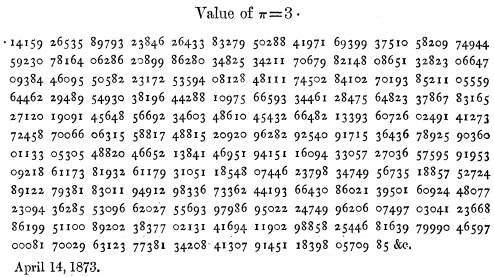 |
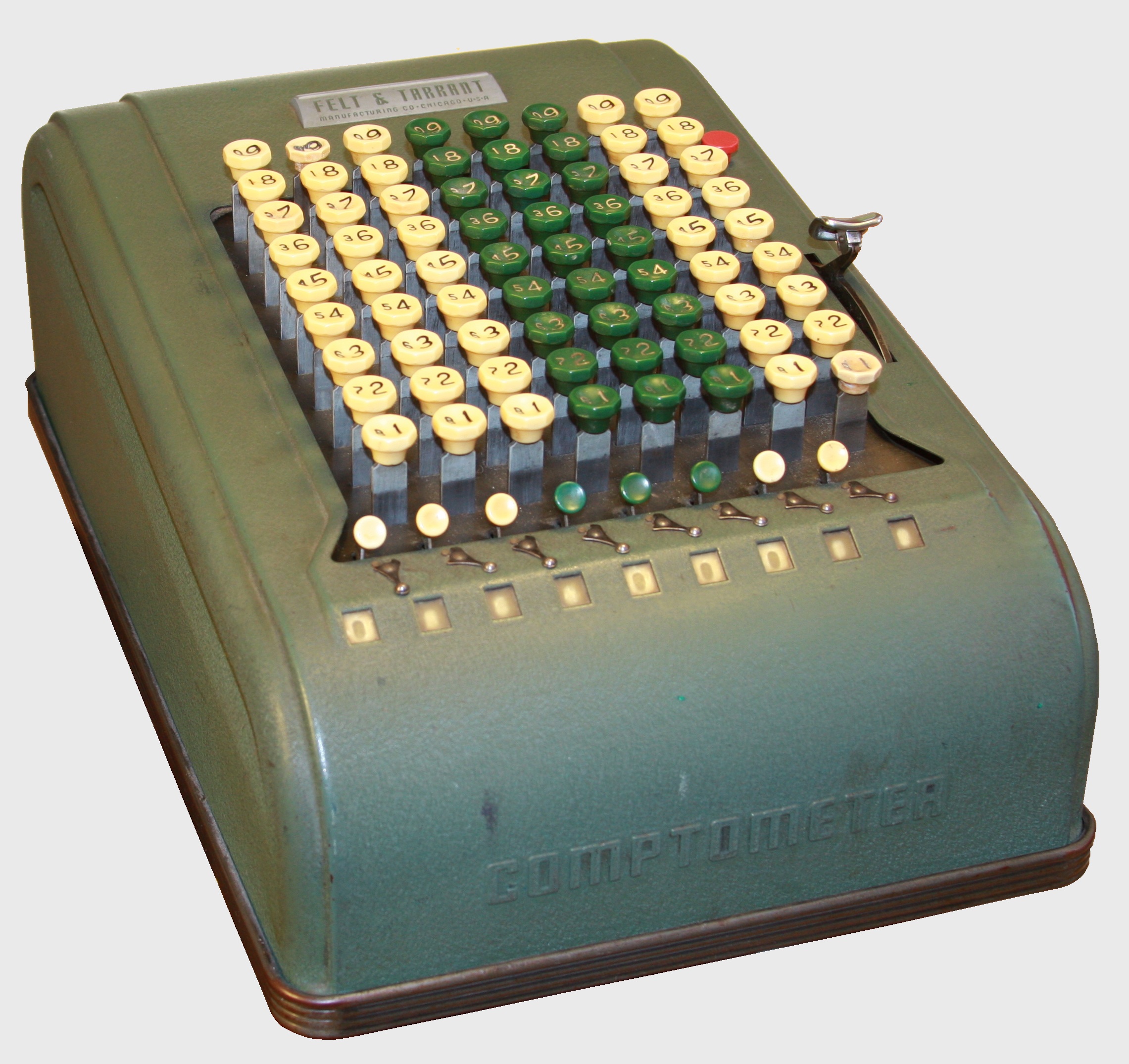
An example of a mechanical desk calculator available in 1945
Ferguson’s Pi were last non-digital calculations[2, pp. 627]; the era of supermen manually computing Pi ended in 1949 when ENIAC cranked out 2047 digits over a three-day holiday weekend[2, pp. 277].
Shanks’ Pi with corrections:
| &c. | |||||||||||||||||||||||||||||||||||||||||||||||||||||||||||||||||||||||
| April 14, 2011. | |||||||||||||||||||||||||||||||||||||||||||||||||||||||||||||||||||||||
The “π Room” Corrected
Unfortunately, I have been unable to find any pictures of the original 1937 “π Room”. I would have really liked to have seen a before and after. Sadly, I can only give you my picture of the after:
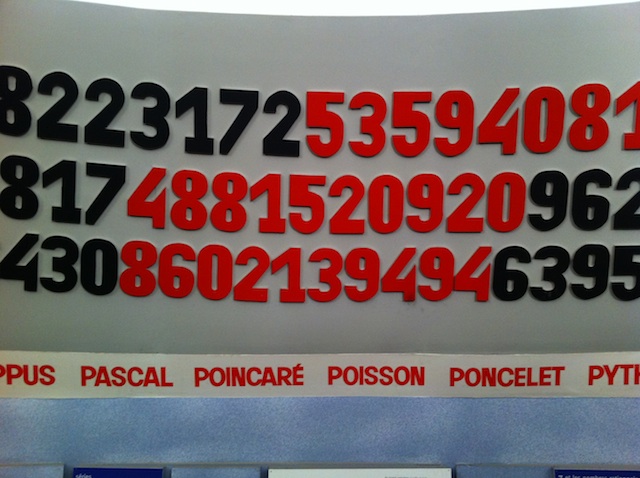
8 6 0 2 1 3 9 4 … Yep, they fixed it.
One More Thing
There is a bonus for the retro nerd at the Palais de la Découverte: 8-bit restrooms:
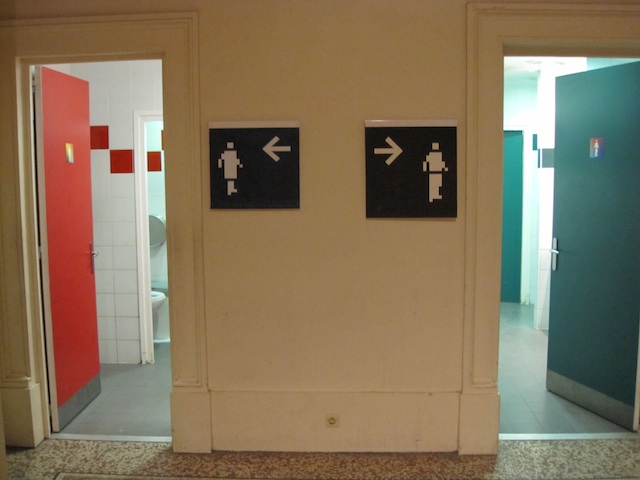
Au Revoir.
Print References
- Arndt, Jörg, and Christoph Haenel. [Pi] – unleased . 2. ed. Berlin: Springer, 2001. Print.
- Berggren, Lennart, Jonathan M. Borwein, and Peter B. Borwein. Pi, a source book . 3rd ed. New York: Springer, 2004. Print.
- Beckmann, Petr. A history of [pi] (pi) . 4th ed. New York: Barnes & Noble, 19931971. Print.
Credits
- Pi Day Deathmatch Poster. Dhemerae Ford (dhemerae@gmail.com).
- First Pi Room Picture: http://www.palais-decouverte.fr/index.php?id=824
- William Shanks Picture: http://shankfamily.us/images/WilliamShank1821e.jpg
- Mechanical Desk Calculator Picture: http://upload.wikimedia.org/wikipedia/commons/e/ee/Comptometer_Model_WM.jpg

 It was the week of October 31th 2010 and I found myself working in NJ. Fortunately, I was only a short train ride away from Manhattan where my kid lives as a student at NYU.
It was the week of October 31th 2010 and I found myself working in NJ. Fortunately, I was only a short train ride away from Manhattan where my kid lives as a student at NYU.